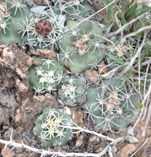Conservation Clues
By Deborah Moors, Photography by Woody Myers
In early June, along Escalante Canyon National Conservation Area in Colorado?s Delta County, three graduate students and 10 undergraduate students worked alongside Bureau of Land Management state botanist Carol Dawson to collect data aimed at protecting the endangered Colorado hookless cactus. Their work was part of UNC Associate Professor Mitchell McGlaughlin?s intensive Field Botany course.
The students recorded the presence of previously tagged plants and new seedlings (which would receive new tags), noted if the plants were flowering and looked for evidence of damage from activities such as grazing. This data was incorporated into a long-term monitoring dataset, which is tracking growth, reproduction and survival.
Estimates of the number of Colorado hookless cactus, which is protected under the Endangered Species Act, range from 25,000 to 45,000 individuals. Although 45,000 plants may seem like a lot, that?s quite low when you consider the abundance of most common plants, according to McGlaughlin. Grazing, oil and gas development, and collections for the horticulture trade are contributing factors to the decline of the Colorado hookless cactus, he added.
"This plant represents part of the Colorado flora and global biodiversity," McGlaughlin said. "It's a beautiful small cactus. Overall, if we lose it, there is no way to replace this unique organism."
McGlaughlin?s passion for teaching his students about plants and their importance, and his research on plant speciation and genetics, offers students unique opportunities. He focuses his research and teaching on using genetic tools — like DNA testing — to understand plant speciation and to help manage and understand plant diversity. His work encompasses rare plant species in the California Channel Islands, Hawaii and Colorado.
The tools he uses, he says, are like the tools used in television's crime series, CSI. Students work to uncover the genetic fingerprints left behind when plants cross with each other, disperse, form hybrids or evolve over time.
From a practical, land management perspective, McGlaughlin explains that genetic identification of plant species helps land managers know if they?re dealing with a federally protected endangered species, and how to manage plants to maintain diversity.
For example, if an area is going to be developed for oil and gas extraction, and they know there are endangered species nearby, they need to really understand those species. If a particular plant depends on a specific pollinator to reproduce or is only found growing in a rare soil type, then land managers need to incorporate that information into their management efforts.
"We're not just collecting academic data in a vacuum," McGlaughlin says. "We're using that data to enhance conservation."





